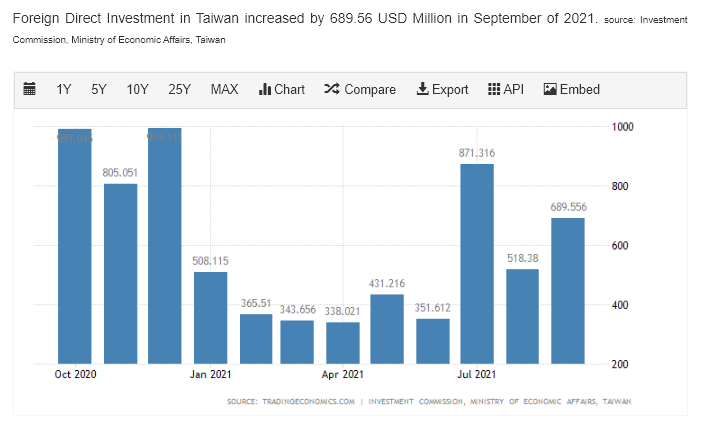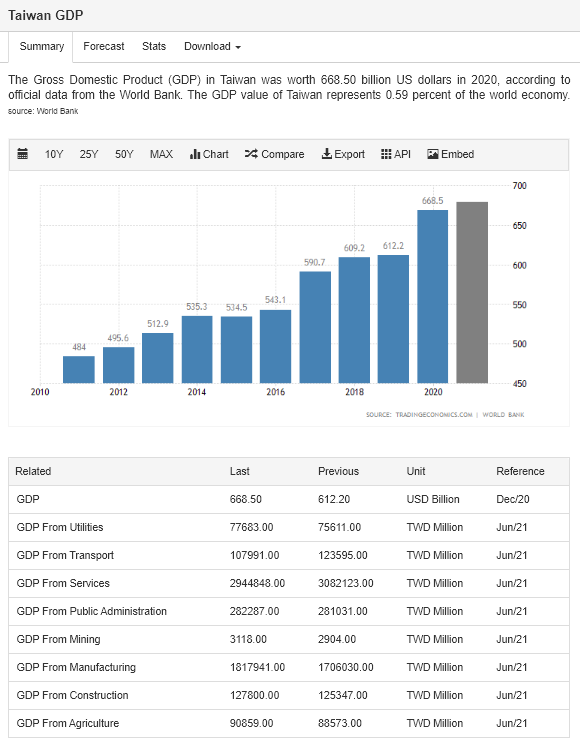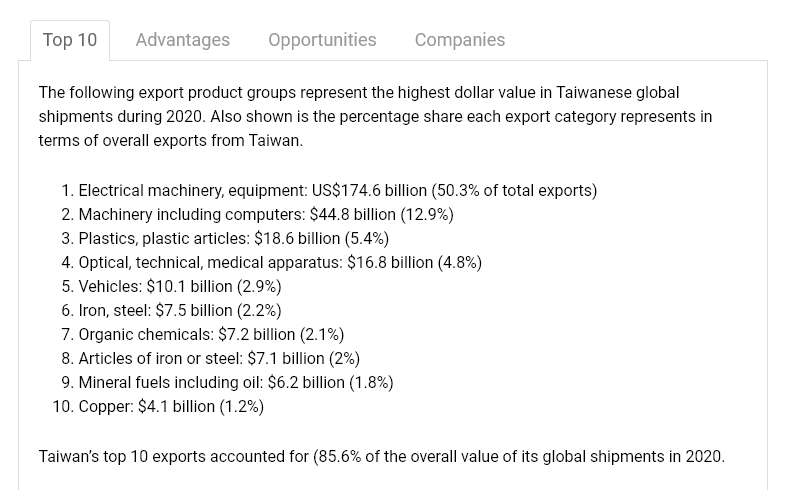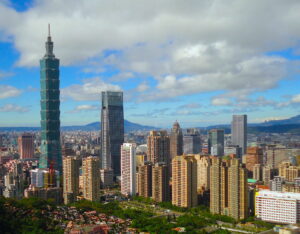If you found this post via search, it probably makes sense to start with the first post in this series. The link to the full series is above.
In this series of posts, I am examining seven specific nations that created economic value which transformed them from fairly poor countries to fairly rich countries.
This post focuses on Taiwan, also known as Formosa.
Table of Contents
Background information
Taiwan is kind of an independent country, and kind of not.
And while that sounds weird, it’s because The People’s Republic of China claims Taiwan as a part of China, and China will not establish diplomatic relations with and will sever diplomatic relations with, any country that establishes diplomatic relations with Taiwan.
As a result, only 15 small nations recognize Taiwan as an independent nation.
An excellent perspective on the absurdity of Taiwan’s nationhood status is this episode of Last Week Tonight, with John Oliver.
After WW2, Taiwan was (again) part of China, and the split between the People’s Republic of China (Mainland China) and the Republic of China (Taiwan) occurred in 1949 when the communist rebels won the Chinese civil war, 1.2 million people fled mainland China for the island of Formosa, and then established themselves as a separate nation, sort of.
The government
Some consider the government of Taiwan to be democratic in form, but not so much in operation.
Taiwan enacted a constitution in 1947, but Taiwan existed under martial law from 1949 until 1987, during which time the constitution was not very relevant.
The Taiwan constitution has since been amended seven times, between 1991 and 2005.
Today, there are five branches, or yuans, of government.
Executive Yuan
The President and Vice President are directly elected every four years.
Legislative Yuan
The legislature has 113 seats, each legislative district elects one member, and legislators serve four-year terms.
Judicial Yuan
The judicial yuan oversees the court system, of which there are two.
In addition to the court system that handles criminal and civil matters, there is an “administrative court” which, if I understand it correctly, handles cases pertaining to public officials.
Control Yuan
This is an interesting concept, at least to me.
The control yuan is a complaint and investigation branch of the Taiwan government and per their Our History page, the concept dates back more than 2,000 years.
If anyone feels someone in the local, regional, or national government is doing anything improper, they can file a complaint and these people in the control yuan follow up and investigate.
Examination Yuan
This idea is not quite as old, going back only to the Tang Dynasty (AD 618-907) and their charter is to identify and select competent people for civil services jobs through open and fair examinations.
Politics
As noted above, from 1949 to 1987 Taiwan was under martial law, but during that period, according to researcher Linda Chao, limited elections were held, and were instrumental in developing democracy in Taiwan, which at first glance does seem counterintuitive.
I’ve requested a copy of her full paper from her, but for now, I have only the abstract.
Her main point seems to be that the initial promise by the then ruling party (KMT) became somewhat “carved in stone” when they made fledgling steps in that direction, and as more and more opposition candidates started to win elections, they realized that to stay in power, they needed to widen democracy and win elections.
Today there are twelve political parties listed as being current on the Wikipedia page on this topic, four of which currently have seats in the national assembly.
The Democratic Progressive Party (DPP) currently has a majority with 62 of the 113 seats.
Taiwan politics has a reputation for getting very rowdy with occasional fistfights, water balloon fights, and once, the throwing of pig intestines within the chamber during a debate about whether or not to allow US pork imports.
Government corruption
Transparency International is an organization that ranks nations on government corruption.
They rank Taiwan as the 28th least corrupt government in the world.
For reference, the United States ranks as the 67th least corrupt government, and Canada recently slipped from 8th place to 12th place.
The legal system
I’m used to the idea that legal systems are based either on English Common Law or French Civil Law.
Why do I think that? Probably because I’m of European descent and lived my entire life in only the United States and Canada.
As near as I can tell, the legal system of Taiwan is based on neither.
The legal system in Taiwan seems to be an amalgamation of French and German Civil Law, carried over from when Japan rules Taiwan, with legal principles from the Qing dynasty, which was the last imperial dynasty in China and lasted from 1644 to 1912.
One thing I think is interesting is Taiwan has two court systems at whose pinnacle sits two Supreme Courts, one for civil and criminal cases, and the other for administrative cases.
As mentioned above, if I’m understanding the idea correctly, administrative cases are cases concerning public officials.
The banking system
The central bank of Taiwan is the Central Bank of the Republic of China, and the currency it issues is the New Taiwan Dollar.
As in almost all modern nations, Taiwan has a fiat currency and a central bank that seeds a credit expansion banking system.
Healthcare
Taiwan adopted a national health insurance system in 1995, which is effectively government-run health insurance.
About 40% of the doctors in Taiwan own their own practices. The rest are employees of hospitals. 80% of practices are single-doctor practices.
Taiwan has a mix of public and private hospitals, and by law private hospitals are nonprofit.
Natural resources
Coal
Taiwan had coal reserves in the past, and they mined them. So while the energy derived from coal helped kick start Taiwan’s manufacturing industries, that resource is now gone and Taiwan imports coal.
Copper
Taiwan has 15 copper mines but I did not find details of copper production.
Gold
Taiwan has 12 gold mines but again, I did not find details of gold production.
Direct government support and intervention
Land reform
When Taiwan came under Chinese control in 1945, about 70% of farmers in Taiwan were tenant farmers, who often paid landlords half their harvest as rent.
The law was changed in 1946 with the goal of making farmers the owners of the land they tilled.
It is considered that this “land to the tiller” program not only worked but transformed Taiwan.
Import substitution
Import substitution was a program whereby Taiwan increased exports, initially through agriculture, in order to obtain foreign currency, in order to use it to buy the stuff needed to enable them to build stuff for export.
There are two recognized distinct phases of this.
Primary import substitution occurred between 1952 and 1957 which allowed Taiwan to implement light manufacturing industries whose output was exported.
Secondary import substitution occurred between 1973 and 1980 which allowed Taiwan to move into high-tech manufacturing.
To illustrate how successful this was, right now the entire world is frustrated that the Taiwan Semiconductor Manufacturing Corporation (TSMC) – which makes one-half of all computer chips manufactured on earth – is unable to keep up with record demand, which is causing a ripple effect through the global supply chain.
Transportation
Government investment in transportation and communications dates back to the late 19th century when the Chinese still occupied the island and built a network of high-quality roads.
This continued during the Japanese period, which started in 1895, and of course, was halted during WW2 for obvious reasons.
The economic growth of the 1960s allowed funding the modern system of roads and modernizing the rail system.
The Taiwanese rail system is still mostly publicly owned, although the high-speed rail line up and down the western side of the island is a public-private partnership.
The four maritime shipping ports in Taiwan are owned by a state-owned corporation, the Taiwan International Ports Corporation.
Mandatory trade union membership
For workers in Taiwan, membership in trade unions is required by law, but there don’t seem to be any penalties for people who don’t join.
Nuclear power
Taiwan operates three nuclear power plants, which generate 8% of Taiwan’s energy consumption and 19% of its domestic energy production.
These nuclear energy plants were built and are owned by the stated owner power company, the Taiwan Power Company.
Direct foreign investment
Taiwan has a history of being very open to direct foreign investment.
A US state department report on the topic states:
Taiwan welcomes and actively courts foreign direct investment (FDI) and partnerships with U.S. and other foreign firms. The administration of President Tsai Ing-wen aims to promote economic growth in part by increasing domestic investment and FDI. Taiwan authorities offer investment incentives and seek to leverage Taiwan’s strengths in advanced technology, manufacturing, and R&D. Expanded investment by the central authorities in physical and digital infrastructure across Taiwan complements this investment promotion strategy. The authorities convene an interagency monthly meeting to address common investment issues, such as land scarcity. Some Taiwan and foreign investors regard Taiwan as a strategic relocation alternative to insulate themselves against potential supply chain disruptions resulting from regional trade frictions. In January 2019, the Taiwan government launched a reshoring initiative aimed to lure Taiwanese companies to shift production back to Taiwan from the People’s Republic of China (PRC) in response to rising tariffs on Taiwan’s critical electronics manufacturing industry.
And the chart below shows the levels of monthly direct foreign investment from Oct 2020 to Sep 2021.

Important partnerships
All I found on this is that in August of 2018, the government announced they were pushing public-private partnerships for infrastructure projects.
GDP by sector
The charts below show GDP growth from 2011 to 2020 as well as GDP by sector for the fiscal year ending in Jun 2021.

Exports by sector
For Taiwan exports by sector, I found this top 10 list:

Wealth and income equality
The most widely used measure of income distribution is the Gini index. It condenses several data points into a single number from 0 (perfect equality) to 1 (perfect inequality), although it is sometimes expressed as a number between 0 and 100.
Taiwan has a 2021 Gini index of 33.6, which ranks it as the 125th most unequal country on earth, which is not bad considering 172 countries are being scored.
For comparison, the Gini index of the United States is 41.1 (54th most unequal) and for Canada is 33.3 (127th most unequal).
In closing
Similar to Singapore, Taiwan has a history of an interesting combination of democracy and authoritarian rule.
Government corruption is low (quite possibly as a result of the control yuan and the administrative courts that exist within their government), and the national government has taken a very hands-on approach to economic development by enacting laws to directly influence and encourage this development.



